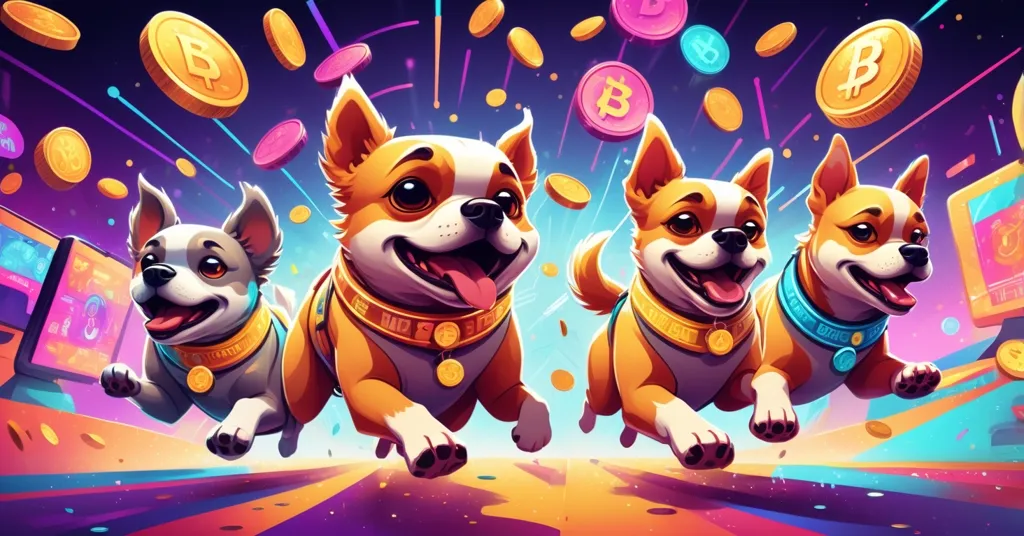Shiba Inu Struggles as Little Pepe and Floki Inu Eye 2025 Memecoin Dominance

Will These 2 Memecoins Explode in 2025? Shiba Inu Falters as Newcomers Battle for Glory
Memecoins are crypto’s loudest carnival barkers, promising overnight riches while often leaving investors burned. As Shiba Inu (SHIB) fades from its 2021 peak, two contenders—Little Pepe (LILPEPE) and Floki Inu (FLOKI)—are hyping massive gains by 2025. But are they the next big thing or just shiny scams in a market littered with broken dreams? Let’s tear through the hype, dissect the data, and figure out if there’s any meat on these meme bones.
- Shiba Inu’s Downfall: Price slumps to $0.000012 with whale selling and impossible market cap goals—think $6 trillion for modest gains—crushing hope.
- Little Pepe’s Gamble: Presale pulls in over $17 million with tokenomics teasing 70-100x returns, yet unverified claims scream caution.
- Floki Inu’s Edge: Pushes beyond memes with Valhalla metaverse and CertiK-audited FlokiFi DeFi tools, aiming for lasting relevance.
Shiba Inu: A Fallen Meme Giant
Born in 2020 as a playful Dogecoin clone, Shiba Inu skyrocketed over 1,000,000% in 2021, turning pocket change into millions for early adopters during a retail-driven frenzy. Its peak near $0.000088 felt like a middle finger to traditional finance, embodying the chaotic, disruptive spirit of crypto. Fast forward to now, and SHIB’s bark has lost its bite. The price has tanked to $0.000012 after a fleeting bump to $0.000017 in July, with technical indicators painting a bleak picture. The MVRV ratio—a metric showing if a token is over or undervalued compared to historical behavior—sits at a dismal -27.79%, signaling distress. Whale selling, tracked via platforms like Whale Alert, shows big players dumping holdings, likely locking in losses or fleeing to greener pastures. For deeper insights into Shiba Inu’s recent price decline and whale activity, the data paints a grim outlook.
Here’s the kicker: for SHIB to crawl back to a modest $0.000025, it would need a market cap of nearly $6 trillion. That’s more than Apple and Microsoft’s combined value today, and double the crypto market’s all-time high of around $3 trillion. Without insane hype or a radical token burn to slash its massive 589 trillion token supply, SHIB looks like a relic of bull market euphoria. But let’s not write it off just yet. The team launched Shibarium in 2023, a layer-2 blockchain designed to cut transaction costs and boost utility, much like Ethereum’s Polygon. Fees on Shibarium partially burn tokens, slowly reducing supply. Adoption’s been sluggish—daily transactions hover in the low thousands per Shibscan data—but it’s a flicker of hope in an otherwise dim outlook. Still, can a meme coin with fading buzz really compete in a space increasingly hungry for fundamentals? Learn more about Shiba Inu’s origins and journey to understand its rise and fall.
Little Pepe: Presale Hype or Scam Alert?
Enough about yesterday’s meme king—let’s size up a fresh pup vying for the crown. Little Pepe, or LILPEPE, is making waves in its Stage 10 presale, priced at $0.0019 per token, with claims of raising over $17.19 million. Early investors are reportedly sitting on 70% gains already, and with a listing price set at $0.003, there’s a built-in 76.5% upside at launch. The buzz centers on its tokenomics—the economic rules governing a token’s supply and distribution. LILPEPE caps its total supply at 100 billion tokens, with only 20 billion circulating at launch, creating scarcity that could spike prices if demand surges. Projections floating around suggest a $1 billion market cap pushes the price to $0.05, while a $5-10 billion cap—a long shot but not unheard of in meme mania—could see it hit $0.25 to $0.50, delivering 100x returns for early backers. Curious about predictions for memecoin gains in 2025? Some analyses spotlight coins like LILPEPE as potential breakout stars.
Sounds like a dream, right? But are you willing to bet on a coin with more red flags than a pirate ship? Here’s the ugly truth: these numbers are unverified, pulled straight from project claims with no whitepaper, smart contract audit, or blockchain explorer data to back them up. Presales are crypto’s Wild West, often a cesspool of rug pulls and inflated hype—think Squid Game token in 2021 or even Bitconnect’s infamous collapse. Investing in LILPEPE is like backing a Kickstarter with no prototype: great if it delivers, disastrous if the creators vanish with your cash. If you’re tempted, do the grunt work—check for locked liquidity on platforms like Etherscan, dig into team credibility (if they’re even public), and demand transparency. For discussions on Little Pepe presale legitimacy concerns, online forums highlight similar skepticism. Without that, this 2025 “explosive growth” narrative smells like the same old snake oil peddled by countless scams. High risk, high reward? Sure. But don’t say we didn’t warn you.
Floki Inu: Utility in a Meme World
Then there’s Floki Inu, a Viking-themed memecoin swinging a battle axe at the notion that memes can’t have substance. Unlike most of its peers thriving on Twitter gifs, FLOKI is building an ecosystem with tangible projects. Valhalla, a play-to-earn NFT metaverse game, lets users battle, trade, and earn in a virtual world—think a blockchain-powered Viking version of Second Life. FlokiFi, meanwhile, offers a suite of decentralized finance (DeFi) tools, including token locking protocols to secure liquidity, a common pain point in memecoin scams. For the uninitiated, DeFi cuts out middlemen like banks, running financial apps on blockchain networks. FLOKI’s tools, backed by a CertiK audit for FlokiFi Locker (a rarity in this space), show a push for legitimacy. Check out Floki Inu’s latest updates on Valhalla and FlokiFi to see their ongoing developments.
Beyond that, FLOKI’s team is playing the long game with global branding campaigns, charitable donations, and consistent developer updates. Recent additions like TokenFi—a platform for asset tokenization—and staking rewards via its sister token TOKEN broaden the ecosystem further. Compared to LILPEPE’s speculative fireworks, FLOKI feels like a steadier bet, though let’s not get carried away—it’s still a memecoin swimming in volatile waters. How does it stack up against heavyweights? Valhalla faces stiff competition from established GameFi projects like Axie Infinity or The Sandbox, while FlokiFi’s DeFi offerings pale next to giants like Uniswap. A Viking coin with a metaverse? That’s either genius or the weirdest cosplay in crypto. For community insights on Floki’s Valhalla metaverse project, the discussions are buzzing with mixed opinions. Still, FLOKI’s efforts to merge meme appeal with utility make it a standout in a sea of fleeting pumps and dumps.
Memecoins vs. Bitcoin’s Vision
Zooming out, let’s ground this circus in the bigger picture. Memecoins thrive in bull markets when retail investors flood the space with FOMO-driven cash—2021’s SHIB and Dogecoin mania being the poster children. But with tighter monetary policies and risk aversion dominating recent years, speculative assets are getting hammered. LILPEPE’s presale hype and FLOKI’s utility plays are pitched against a hopeful 2025 outlook, likely tied to a post-Bitcoin-halving rally in 2024 that could reignite retail madness. Bitcoin’s halving, where mining rewards are cut in half roughly every four years, often sparks market cycles by tightening supply—historically a catalyst for broader crypto gains. If you’re looking into memecoin price predictions for 2025, the forecasts often hinge on such market cycles.
As Bitcoin maximalists, we see memecoins as a double-edged sword. On one hand, they draw eyeballs to crypto, potentially onboarding new users who might stumble into Bitcoin’s orbit. On the other, their casino-like volatility and frequent scams distract from Bitcoin’s core mission as sound, decentralized money. Still, we can’t ignore that altcoins and niche experiments fill gaps Bitcoin doesn’t—entertainment, community vibes, and tech testing grounds. FLOKI’s DeFi tools, for instance, accelerate blockchain innovation in a chaotic, messy way that aligns with effective accelerationism, pushing the boundaries of what decentralized systems can do. For a detailed look at Floki Inu’s DeFi tools and overall utility, reviews highlight its ambitious ecosystem. SHIB’s Shibarium, sluggish as it is, toys with layer-2 scalability that could indirectly benefit Bitcoin’s ecosystem. LILPEPE? Well, that’s just a straight-up gamble with little to tie it to decentralization’s ethos—yet it’s part of the disruptive energy that defines this space.
Let’s not dodge the elephant in the room: regulatory heat. With the SEC cracking down on altcoins as potential unregistered securities, memecoins could face legal hurdles by 2025. A single ruling could turn projected gains into investor pains. Plus, the psychology behind memecoins—pure FOMO and dreams of lambos—clashes with Bitcoin’s value proposition of scarcity and utility. So why do people keep buying? Because the promise of a 100x moonshot taps into raw human greed, a force as old as money itself.
Key Takeaways and Critical Questions
- Why is Shiba Inu (SHIB) losing ground in the memecoin race?
SHIB’s price has cratered to $0.000012 amid whale selling and a brutal MVRV ratio of -27.79%, with a $6 trillion market cap needed for modest gains—a pipe dream without massive hype or token burns. - What makes Little Pepe (LILPEPE) a hyped 100x play for 2025?
Its presale claims over $17 million raised at $0.0019, with tokenomics (20 billion of 100 billion tokens at launch) projecting prices of $0.05-$0.50 at higher market caps, though unverified data casts major doubt. - How does Floki Inu (FLOKI) stand out from typical memecoins?
FLOKI blends utility with meme appeal via Valhalla metaverse and CertiK-audited FlokiFi DeFi tools, plus global branding and ecosystem expansions like TokenFi, positioning it for longer-term relevance. - Should investors trust presale projects like LILPEPE in the crypto space?
Hell no, not without hardcore due diligence. Unverified claims and missing audits mirror past scams—check smart contracts, liquidity locks, and team credibility before even thinking about investing. - Do memecoins align with blockchain’s goals of decentralization?
Partially—they spotlight crypto and test niche innovations Bitcoin skips, like FLOKI’s DeFi experiments, but their speculative nonsense often dilutes focus from Bitcoin’s sound money mission. - What broader market trends could impact memecoin gains by 2025?
Bitcoin’s 2024 halving, potential interest rate cuts, and renewed retail FOMO could fuel a bull run, boosting memecoins, though regulatory crackdowns or economic downturns might kill the party.
So, where do we stand? SHIB feels like a washed-up star, clinging to relevance with half-measures like Shibarium while its price languishes. LILPEPE is the quintessential high-stakes gamble—potentially explosive if legit, but don’t bet the farm until there’s hard proof of credibility. FLOKI offers a refreshing twist with actual ecosystem development, though it’s still navigating speculative tides against bigger players. For Bitcoin purists, these tokens are noisy sideshows, yet they embody the raw, disruptive spirit that keeps crypto pushing boundaries. If you’re dipping into memecoins, tread damn lightly—set strict stop-losses, allocate only ‘fun money,’ and never trust a project without audited contracts. As 2025 looms, the real test is whether these memes can ride a market wave or if they’ll crash and burn like so many before them. Stick to fundamentals, keep your eyes peeled, and remember: in crypto’s game of digital roulette, the house often wins.



